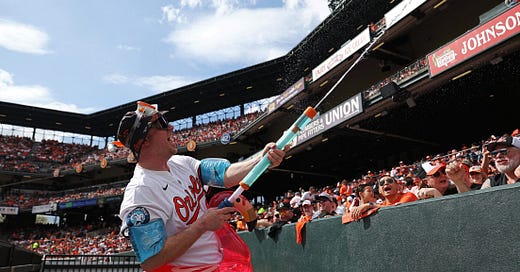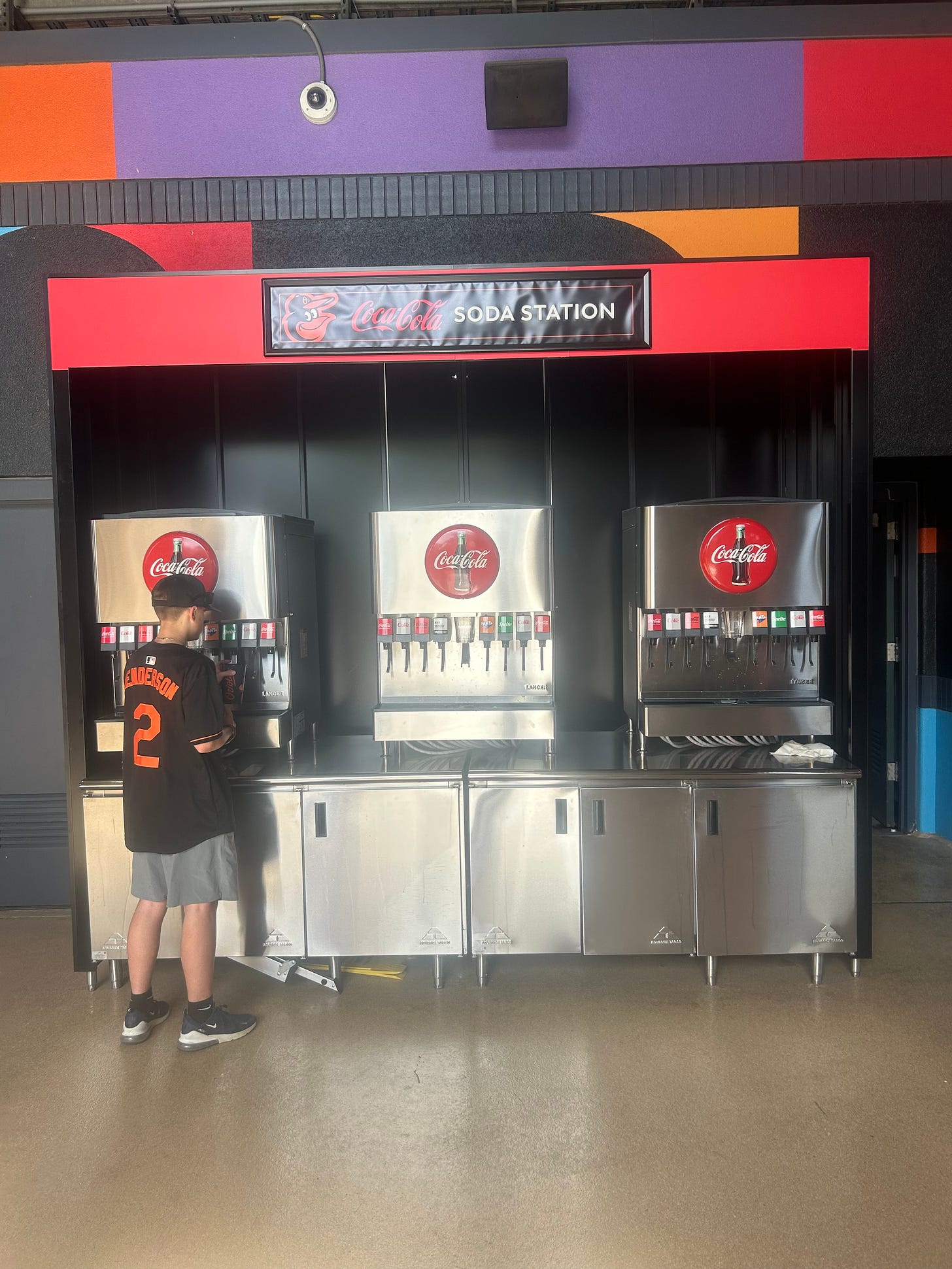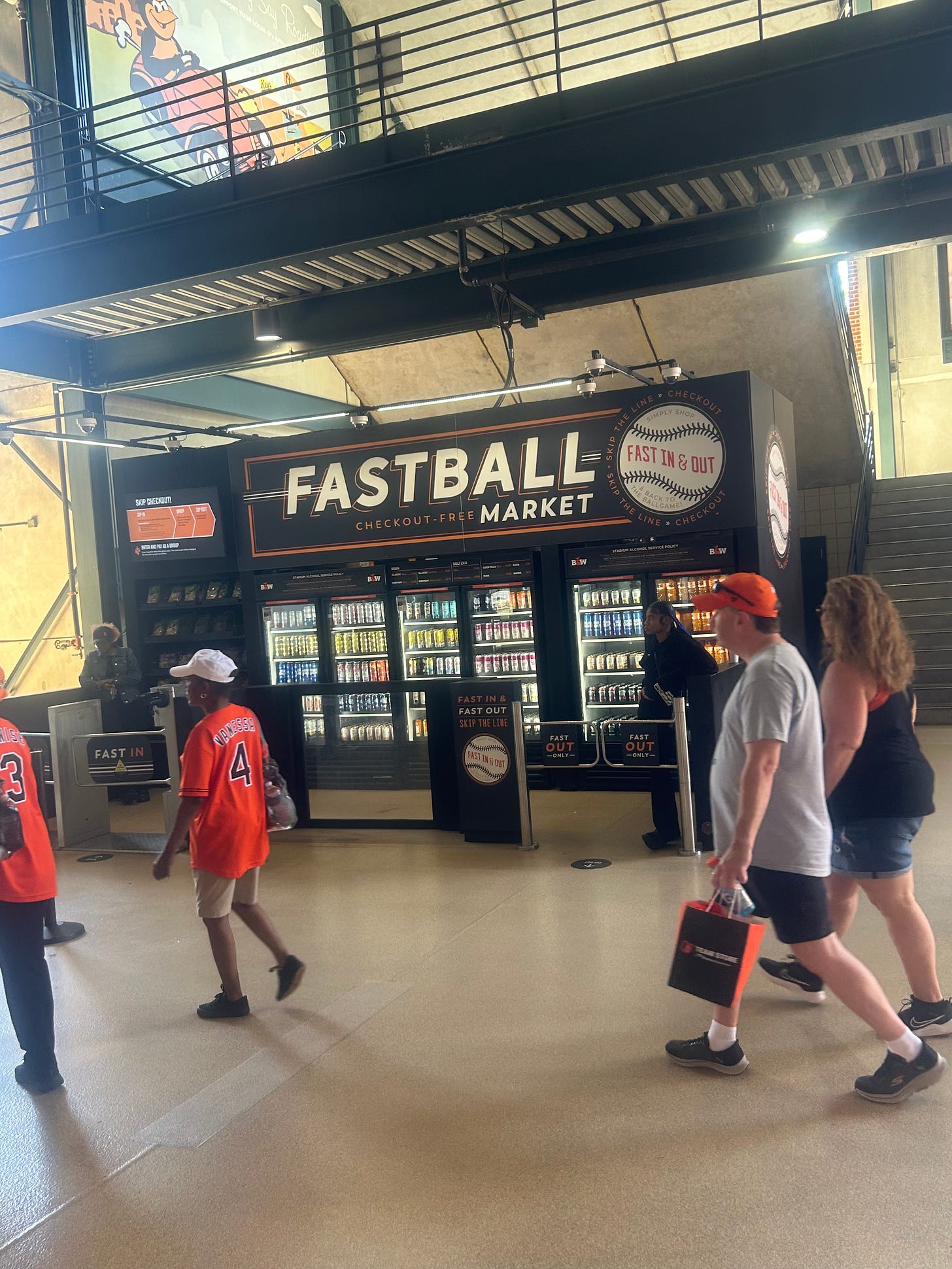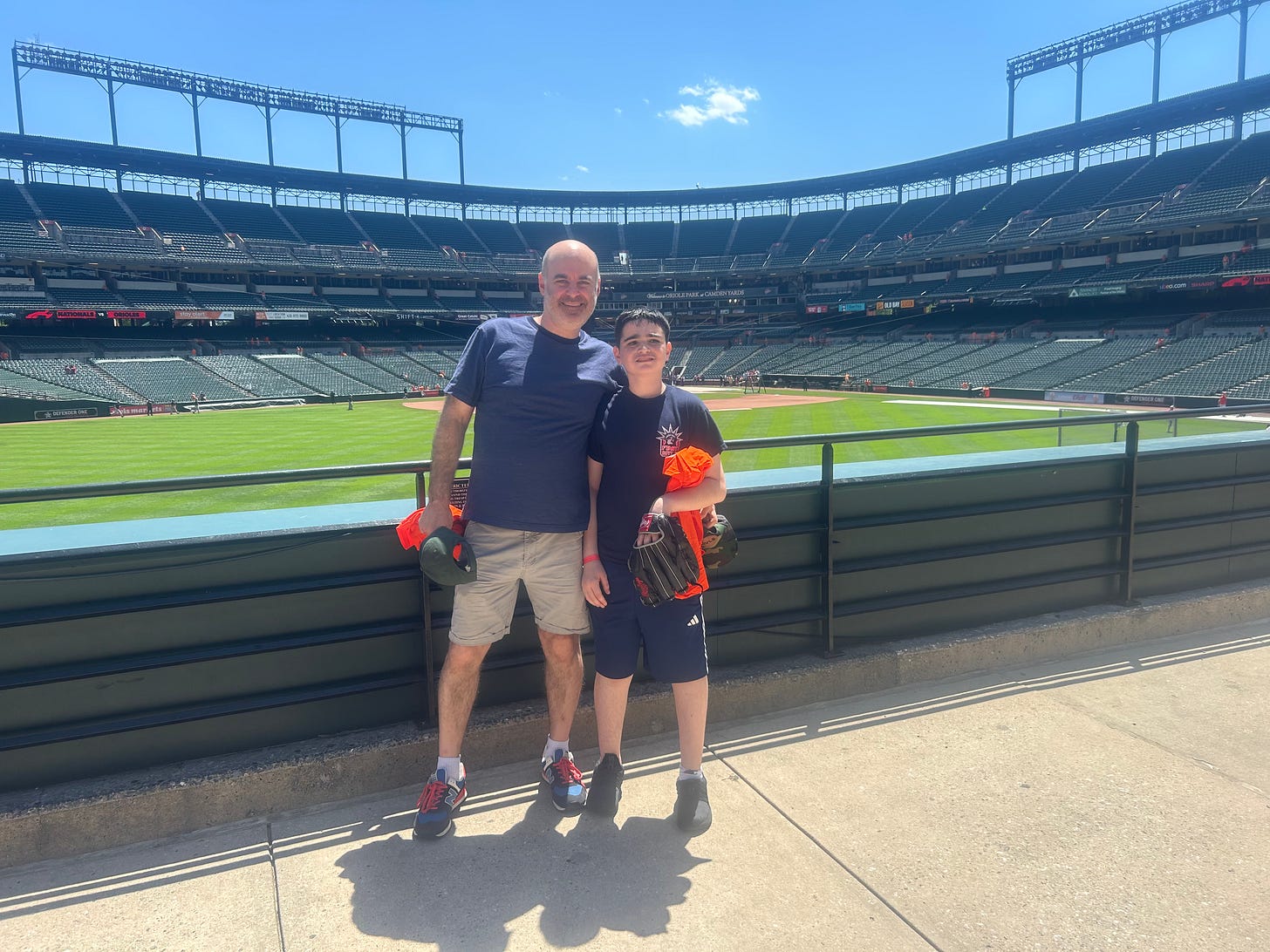Camden Yards, Engineered Enthusiasm, and the Illusion of Fun
The last stop at this weekend’s father-son road trip was Baltimore and Camden Yards for a baseball game.
Let’s be clear: Camden Yards is a gem.
It’s gorgeous, efficient, and run by people who seem to care. The concourses are vast, the bathrooms clean, the concessions fast, and the ushers are some of the kindest, most helpful people you’ll find in any stadium in the country. There's even a real live human manager at a help kiosk—like it's 1997 and customer service still exists.
On the surface, it feels like a win.
Until you sit down… and your team gives up seven runs in the first inning. The starter doesn’t make it out alive. By the second, you're watching a bullpen guy mop up a full-blown disaster. And here’s the kicker: you already knew the manager was fired—because the news broke as you walked into the stadium.
So before the first pitch, the tone was already set: chaos inside the clubhouse, collapse on the field. But don’t worry—the hose still works. Mr. Splash is ready. Let the games begin.
This is where Camden Yards flips from cathedral to stage set. Because the team might be down double digits, but the show must continue. Cue the lights. Cue the hose. Cue the Bird Bath Splash Zone™.
The Hose Knows No Shame
If you haven't had the pleasure, the Bird Bath is the Orioles' wet 'n wild hype zone, now expanded to Sections 84 and 86. Every double, triple, or home run triggers a water party led by Mr. Splash, the so-called "Chief Hydration Officer." There are coordinated cheers. There are hand motions ("turn on the faucet!") and props ("drink from the homer hose!"). It’s part foam party, part theme park, part TikTok bait.
As I was sitting there watching the chaos unfold on the field—and a man with a water cannon celebrate it like we were up by five—I realized something:
I had a name for this. A phrase that captures not just this moment, but a pattern I’ve experienced across brands, businesses, and even that hotel I booked the night before.
Engineered Enthusiasm.
It’s not just marketing spin. It’s an entire playbook. A manufactured environment designed to simulate joy, hype, and belonging—even when the core product is falling apart.
Kids love it.
Some adults do too.
But when you're down 9-1, and your manager’s already been canned, it starts to feel like you're watching your house burn down while the sprinkler system throws a rave.
The Jumbotron Hype Machine
Another thing you start to notice is that almost all of the Jumbotron coverage comes from the Splash Zone. It’s camera after camera pointed at Sections 84 and 86. It makes sense—those fans are the most animated, drenched, and choreographed.
But that’s just it. It’s not organic enthusiasm. It’s a manufactured hot zone. We were featured on the big screen several times, not because we were doing anything special. We were sitting in a half-empty section and the camera needed something.
Being on the Jumbotron should feel fun. Unique. Like you stood out. You earned it at Yankee Stadium if the camera lands on you in the bleachers. Maybe you’ve got a clever sign. Maybe you’re in full costume. Maybe you’re just radiating raw fan energy. The point is: it’s based on merit and creativity.
At Camden Yards, it felt more like being background noise in someone else’s scripted highlight reel.
Orange Out Saturdays and Live Bands, Because Why Not?
And if the splash zone wasn’t enough? Don’t worry. Every Saturday, there’s a live band playing tunes curated explicitly for the nostalgia receptors of 30- and 40-somethings. You’ll hear post-grunge, alt-rock, and maybe even a pop-punk cover of “Tubthumping.”
Meanwhile, there’s orange-themed food. Orange shirts. Orange decor. Orange drinks. It’s Orange Overload. Every surface, every song, every scent is calibrated to keep you smiling long enough to forget the scoreboard.
Concessions with Soul: Food That Works, Pricing That Matters
Camden Yards' food isn’t just “good for a stadium.” It’s good, period. Flavorful, thoughtful, and crafted. The queso-smothered Warehouse Burger? A gut bomb with a PhD in craveability. The Chesapeake sausage drowned in crab dip and tucked into a pretzel bun? Equal parts chaos and genius. Someone in the kitchen didn’t just crank this stuff out—they cared.
And the people serving it? Dialed in. Friendly. Fast. Actually smiling like they meant it. You don’t feel like you're being processed. You feel like you're being hosted.
But here’s where it really hits: the Birdland Value Menu.
This isn’t a limited promo or a “look at us” PR stunt. It’s a full-on price reset, spread throughout the park. $4 for soda, nachos, pretzel bites, or a hot dog. $2.50 peanuts. $3 popcorn. $5 beers. And not “behind Section 348, only on Tuesdays”—we’re talking main concourse, upper deck, real access.
And yes, refillable soda cups are real. Unlimited refills, $4. Try finding that anywhere else in Major League Baseball. In a world where bottled water hits $7 and beer cracks $18, this isn’t generosity—it’s an act of economic sanity.
And then there’s the tech—and I don’t mean "new for the sake of new." I walked into the Fastball Market, scanned my credit card at the entrance, grabbed a beer, and walked out. No checkout. No lines. No awkward kiosks. Just... gone. Like an Amazon Go store dropped into a ballpark. It worked. It didn’t glitch. It was fast, easy, and exactly what it should be.
It’s the kind of seamless CX we used to daydream about building back at Mastercard—integrated systems where hardware, software, and real-world friction actually disappear.
Camden Yards isn’t talking about “the future of fan experience.”
They’re quietly living it.
That’s the magic inside the gates.
But just outside? That’s where the fantasy ends.
And then you leave.
I parked in a garage not affiliated with the stadium. The concrete was cracked. There were no lights in key areas. Entire sections looked like they hadn’t been touched since the '80s. And in case the ambiance wasn't unsettling enough, six people in hazmat suits were roaming the garage. No signs. No explanation. No logos. Just head-to-toe gear like something out of Chernobyl: The Parking Lot Edition.
That garage was the overture to a harsh reality. Narcan packets on the sidewalk. Open drug use. People passed out in doorways. Trash everywhere. Panhandlers in obvious distress. Police nearby—not preventing chaos, just watching it unfold.
To put it bluntly: I’ve parked in the Bronx. I’ve parked in Queens. I’ve never felt that unsafe walking to a stadium. And nothing on the Orioles’ website, or in any pre-game promo, prepares you for that contrast between inside the gates and outside the fantasy.
And that’s why the Birdland Value Menu matters.
That’s why free refills aren’t just a “nice touch.”
These aren’t ballpark luxuries. They’re concessions on concessions—a quiet acknowledgment that the economic climate around the stadium is rough, and that sometimes, making things affordable is the marketing strategy. Camden Yards isn’t just creating experiences. It’s giving people in a struggling city a reason to show up still..
Yankees and Mets Fans Don’t Need the Circus
Here’s where the contrast really hits: in New York, nobody’s blasting you with a hose to get you excited.
I’ve sat in the bleachers at Yankee Stadium. The fans bring the energy independently—because they expect the team to deliver. Same goes for the Mets. Sure, Citi Field has its perks, but nobody’s relying on a foam party to create loyalty. New York fans show up because the tradition, the tension, and yes, the pressure—it’s real.
Now, don’t get me wrong—I wish Yankee Stadium had more customer-first upgrades. I wish beers weren’t $17. I wish the food wasn’t aggressively average. But the reason it doesn’t have to improve is simple: supply and demand. The brand is strong. The expectation is performance. And most of the time, the product is good enough to keep people coming back without needing a circus.
In Baltimore, it’s a different equation. The team has to earn every ticket. And the result is a stadium experience that works overtime to create value, vibe, and entertainment—because the baseball isn’t always enough on its own.
Engineered Enthusiasm Is Everywhere
This isn’t just about the Orioles. It’s not even just about sports.
Engineered enthusiasm is the new default setting in marketing.
Don’t have a great product? Distract with a cause.
Can’t fix the service? Launch a mascot.
Underwhelming app? Add confetti animations and “power users.”
Boring campaign? Just call it a movement and hope for retweets.
We see it in:
Retail stores pumping scent and music to mask empty shelves
Conferences that feel like TED Talks but sell nothing but access
Loyalty programs that require spreadsheets to decode
Brands with no soul slapping “community” on everything
Politicians, apps, and yes, baseball teams faking momentum because they’re too scared to face what happens without it
And the scary part? It works—sometimes.
You remember the splash. Your kid remembers the foam. You Instagram the orange drink. And you leave saying “that was fun,” even if the team got throttled and the real-world walk back to your car felt like a scene from The Wire: Season 8.
But for those of us watching a little more closely, it’s hard to shake the hollowness.
Final Score: Manufactured, But It Worked
Here’s the thing: I’m not an Orioles fan. I wasn’t there for a playoff push. I wasn’t chasing nostalgia. I just wanted a decent day at the ballpark with my kid.
And you know what?
I had fun.
My son had a blast.
He got soaked. He laughed. He waved his rally towel like it meant something. He didn't care about the scoreboard or the fired manager or the bullpen parade. He just knew he was at a place that made him feel part of something. And honestly—isn’t that the point?
So yeah—the enthusiasm was manufactured. The noise was engineered. The vibe was scripted. But the people delivering it were sincere. The food was excellent. The tech worked. And somehow, all of it came together in a way that felt... real enough.
Because sometimes, especially in a city that’s hurting, manufacturing joy is better than not trying at all.
So no—I won’t be buying season tickets. I won’t be switching allegiances.
But if you asked me whether I’d go back?
Absolutely.
Just maybe not for the pitching.
So yes—it was manufactured. But it worked.
The MAC Reality Check
Camden Yards is doing the best version of engineered enthusiasm you’ll find. The food, the hospitality, the pricing, the experiences—they’re top-tier. It’s a world-class operation wrapped around a team that isn’t always worth the effort.
So here’s the uncomfortable truth:
You can build the most fan-friendly ballpark in America.
You can install splash zones, live bands, and food trucks.
You can engineer all the joy you want.
But when the product stinks, it eventually seeps through.
The hose can’t save you from a losing team.
The band can’t mask a fired manager.
The orange-themed donuts won’t get you to October.
Real enthusiasm?
You don’t need to engineer it.
You just need to earn it.
About This Article: The MAC Compass Disclosure
This piece wasn’t sponsored. It wasn’t commissioned. It wasn’t part of any brand campaign.
It was written after a single visit to Camden Yards—just me, my son, a couple beers, and a brain hardwired to notice how marketing tries (and sometimes fails) to create meaning. It started with a mental note. Then a phrase: engineered enthusiasm. Then a realization that what I saw at a baseball game was the same thing I’ve seen across years of brand work, strategy decks, CX roadmaps, and keynote stages.
To support the narrative and fact-check details, I used publicly available sources, including:
Orioles announce new features at Oriole Park for the 2025 season
Here’s to the Night, the band featured during Orange Out Saturdays
This article was developed using the Reality Check GPT, a custom writing and editing assistant built with the values of the Marketing Accountability Council in mind. It helped sharpen structure, tone, and clarity—but every word, story, and critique was personally written, reviewed, and approved by me.
The lens I used throughout is what I call the MAC Compass—a framework rooted in authenticity, accountability, transparency, and truth-seeking. No fluff. No pitch deck language. Just honest reflection on what works, what doesn’t, and what brands need to do better—especially when the product can’t carry itself.
If this felt more like a gut check than a game recap, good.
That was the point.
— Written and experienced firsthand,
with MAC values in the passenger seat,
and Reality Check GPT riding shotgun.







